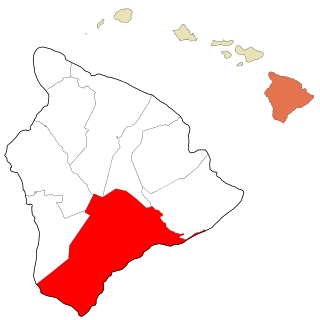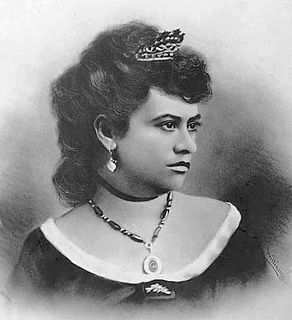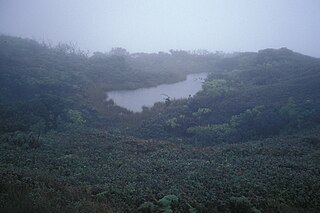
ʻEwa Beach or simply ʻEwa is a census-designated place (CDP) located in ʻEwa District and the City & County of Honolulu along the leeward coast of Oʻahu in Hawaii. As of the 2010 Census, the CDP had a total population of 14,955. The U.S. postal code for ʻEwa Beach is 96706.

A luau is a traditional Hawaiian party or feast that is usually accompanied by entertainment. It may feature food such as poi, Kalua pig, poke, lomi salmon, opihi, and haupia, beer, and entertainment such as traditional Hawaiian music and hula. Among people from Hawaiʻi, the concepts of "luau" and "party" are often blended, resulting in graduation luaus, wedding luaus, and birthday luaus.
Aliʻi in the Hawaiian language refers to the hereditary line of rulers, the noho aliʻi, of the Hawaiian Islands. Aliʻi has a similar meaning in the Samoan language and other Polynesian languages, and is a cognate of the Māori word "ariki".

ʻAkaka Falls State Park is a state park on Hawaiʻi Island, in the U.S. state of Hawaii.
A Hawaiian name is a name in the Hawaiian language. Such names are popular not only in Hawaiian families, but also among other residents of Hawaii, and even in the United States mainland among both non-native and native Hawaiians.

Kaʻū is the southernmost district of Hawaii County, Hawaii, located on the island of Hawaiʻi.

A heiau is a Hawaiian temple. Made in different architectural styles depending upon their purpose and location, they range from simple earth terraces, to elaborately constructed stone platforms. There are heiau to treat the sick, offer first fruits, offer first catch, start rain, stop rain, increase the population, ensure the health of the nation, achieve success in distant voyaging, reach peace, and achieve success in war (luakini).
"Mahalo" is a Hawaiian word meaning thanks, gratitude, admiration, praise, esteem, regards, or respects. According to the Pukui and Elbert Hawaiian Dictionary, it is derived from the Proto-Polynesian *masalo.

Mary Abigail Kawenaʻulaokalaniahiʻiakaikapoliopelekawahineʻaihonuaināleilehuaapele Wiggin Pukui, known as Kawena, was a Hawaiian scholar, dancer, composer, and educator.

Kaʻiminaʻauao was a Hawaiian high chiefess who was given in adoption to Queen Kalama and King Kamehameha III. She died of the measles at the age of three, during an epidemic of measles, whooping cough and influenza that killed more than 10,000 Native Hawaiians. Her elder brother and sister became King Kalākaua, and Queen Liliʻuokalani.

Victoria Kūhiō Kinoiki Kekaulike II (1843–1884) was a Princess of the Kingdom of Hawaiʻi. Her name also sometimes spelled as Kinoike Kekaulike has been written as Mary Kinoiki Kekaulike in many sources. Her name Kekaulike translates as "the equality" in Hawaiian.

Nototrichium is a genus of flowering plants in the pigweed family, Amaranthaceae. All members of the genus are endemic to the Hawaiian Islands. They are known in Hawaiian as kuluʻī.

Kuhlia sandvicensis, the Reticulated flagtail, is a species of flagtail native to the waters around several Pacific islands where it occurs in fresh, brackish and marine waters. This species can reach 21.4 cm (8.4 in) in standard length. It is popular as a game fish and can also be found in the aquarium trade.
Diospyros hillebrandii, is a species of flowering tree in the ebony family, Ebenaceae, that is endemic to the islands of Oʻahu and Kauaʻi in Hawaii. Its common name, Ēlama, also means torch or lamp in Hawaiian. Ēlama is a small to medium-sized tree, reaching a height of 4–10 m (13–33 ft). It can be found in coastal mesic and mixed mesic forests at elevations of 150–760 m (490–2,490 ft).

A kāhili is a symbol of the aliʻi chiefs and families of the Hawaiian Islands. It was taken by the Kamehamehas as a Hawaiian royal standard and used by the Royal Families to indicate their lineage.
Levi Haʻalelea was a high chief of the Kingdom of Hawaii. He served as a kahu and konohiki for High Chief Leleiohoku, one of the grandsons of Kamehameha I, a Hulumanu from the Royal Court of Kamehameha III, and eventually served as Chamberlain for the court. He was a member of the Privy Council and served in the House of Nobles. He helped the early Mormon missionaries to the islands by leasing them land and eventually converted to that faith. In the Hawaiian language, his name Haʻalelea meant man sacrificed when cutting an ʻōhiʻa tree for an image.
Ka Nupepa Kuokoa was a Hawaiian language newspaper which ran in circulation for 66 years (1861-1927) as the most popular Hawaiian national journal. In the Hawaiian Language kuokoa means "independent". The paper was begun in 1861, shortly after David Kalākaua began the first Hawaiian language, national paper entitled; Ka Hoku o Ka Pakipika edited by Hawaiians for Hawaiian interests. Henry Martyn Whitney, the son of missionaries began Kuokoa to run alongside his other publication, the Pacific Commercial Advertiser soon afterwards.

ʻEwa was one of the original districts known as moku, of the island of Oʻahu in Ancient Hawaii history.
Ulukau: The Hawaiian Electronic Library is an online, digital library of Native Hawaiian reference material for cultural and Hawaiian language studies. The services are free and are provided and maintained by Kahaka ‘Ula O Ke’elikolani College of Hawaiian Language at the University of Hawaii at Hilo and Ka Waihona Puke 'Ōiwi Native Hawaiian Library at Alu Like. The site is available worldwide, containing Hawaiian language newspapers, books and other resources with mirror sites in both English and Native Hawaiian. Western studies of Hawaii tend to ignore the Hawaiian language newspapers. These digital archives serve to make these sources available for educational and scholarly work. The collaboration between Ho‘olaupa‘i, Hale Kaumo‘o and Alu Like contain the largest collection of digitized native language newspapers in the Pacific with nearly 125,000 pages accessible within Ulukau. The library's digital dictionary, is Nā Puke Wehewehe ‘Ōlelo Hawai‘i. In the Hawaiian language the term Puke Wehewehe ‘Ōlelo means dictionary. Photographer Ed Greevy, who helped illustrate several books including: "A Nation Rising: Hawaiian Movements for Life, Land, and Sovereignty", has donated a good deal of his work to the Hawaiian electronic library.

Violet Lake, is a small high-elevation lake located at 5,020 ft (1,530 m) above sea level on Mauna Kahalawai, situated in the western part of the island of Maui. It is located in the boggy slopes near the ʻEke Crater and Puʻu Kukui, the highest peak of the West Maui Mountains. It is approximately 10 ft × 20 ft in size.















